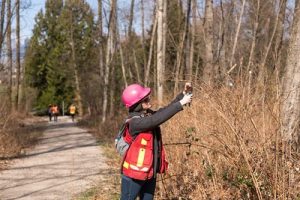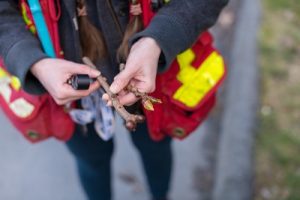
Congratulations to BCIT alumna and Forest Resources faculty Julia Alards-Tomalin’s Open Education Resource Textbook Buds, Branches, and Bark: A Guide to Winter Identification in the Pacific Northwest for being named a recipient of the Open Pedagogy Award in the 2023 Global Open Education Awards for Excellence.
The Global Open Education Awards for Excellence recognize outstanding leaders, significant contributors in the Open Education community, and unique Open Education Resources. This year’s award saw over 170 nominations from across 38 different countries. As one of this year’s 16 winners, Julia’s award falls in the Open Practices category, which recognizes the collective behaviours and techniques that open up access to educational opportunities. In particular, these practices promote and support the use of open educational resources, technologies, and social networks to facilitate collaborative and flexible teaching and learning.
What’s unique about this open textbook?

Buds, Branches, and Bark: A Guide to Winter Identification in the Pacific Northwest is an open textbook that involved collaboration from nearly 200 students and faculty from three BCIT schools to complete. They have located, researched, and photographed specimens, composed descriptions, edited content, and designed layouts for information on how to identify more than 40 different plants in the winter.
As shared by an Award Reviewer, “Open pedagogy on even a small scale can be challenging, so to pull off an interdisciplinary project involving nearly 200 students across three schools is quite an achievement. It sounds like the project has not only succeeded in terms of the learning experience for students but has also benefited the institution in terms of building relationships.”
Julia echoed how special it is to be a part of something so remarkable.
“It’s one thing to have crafted something like this myself, but to have so many students and faculty members involved makes it that much more special. It’s really all of us winning the award because I couldn’t have done it without them.”
Have you subscribed? Sign-up to receive the latest news on BCIT.
A blossoming idea

The idea for the book started during Julia’s time as a student at BCIT then carried into her teaching days. As a student, Julia realized that the timing of most plant identification courses over winter was a challenge as the vast majority of textbooks and guides provide photos and notes based on how plants and trees look in the summer.
In 2020, the first edition of the textbook was completed remotely as COVID-19 pandemic restrictions limited in-person research capabilities. As pandemic restrictions lifted, the second edition saw student researchers in the field making their own observations and gathering their own data.
With the success of the second edition and the educational opportunities available for students to gain hands-on experience and knowledge in the field, Julia has a third edition well underway, with a scheduled release date for December 2023.
“The work we put in was so valuable and inspiring for the students to see what they are capable of,” explained Julia. “So, I’d like to see us continue to build on what we’ve crafted and continue to invite students to be a part of the teaching process, participating in the co-creation of knowledge.”
Read the detailed story about how Julia Alards-Tomalin’s experience of collaborating with faculty and students to bring to life the Open Educational Resource textbook Buds, Branches, and Bark: A Guide to Winter Identification in the Pacific Northwest.
(Caption for top image: Julia uses a hand lens to magnify and examine the tiny structures within the flower buds of the Red Maple. Observing closely is an important step in winter plant identification.)
